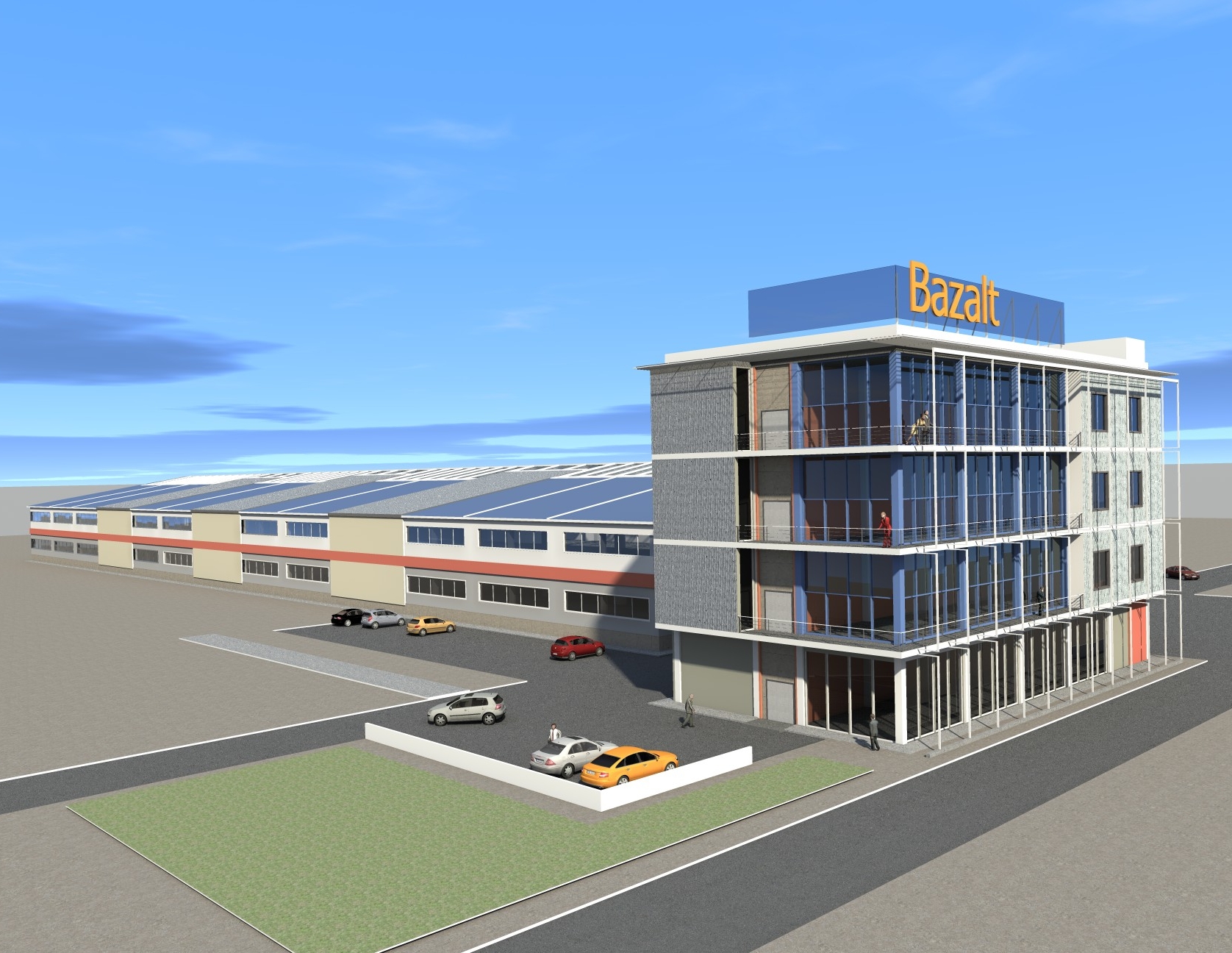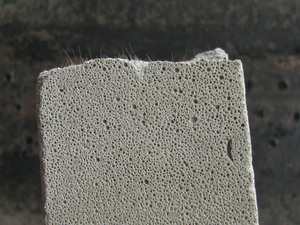 Dr.
Aleksandr
Novytskyi
Processing of rock
basalt types in
different types of
fiber, a personal
information site
Dr.
Aleksandr
Novytskyi
Processing of rock
basalt types in
different types of
fiber, a personal
information siteCHOICE OF RAW MATERIALS FOR THE PRODUCTION OF BASALT FIBERS FOR VARIOUS USES
According to the research, taking into account the properties of the rocks, we have developed recommendations for the use of rock melts for the production of specific types of fibers (see Table 1). Classification of rock melts was made Makhova MF et al., but has not been made to optimize the properties of melts of specific species indicating the direction of their use. We have found that the high viscosity of melts may obtain continuous fiber. However, the process is characterized by the largest energy consumption and the maximum wear assembly fiberization by its operation at elevated temperatures. When using viscous melts continuous fiber production process is stable. The manufacturing process of superfine fibers is the bushing at elevated temperatures above 1360 ° C, which in turn has increased wear, the resulting fiber satisfactory quality. Group rocks with medium viscous melts are the most versatile raw material for the production of all types of fibers. The production process is continuous and super fine fiber runs from the lowest energy costs.
Table 1
Use of rock for the production of different types of fibers
|
class melt |
raw material |
Viscosity, ¶Па×с at a temperature |
Use of raw material |
|
|
1450°С |
1300°С |
|||
|
High viscosity |
Andesites |
more 150 |
more 1000 |
Applications not found |
|
Viscosity |
Andesite
basalts, |
50-150 |
200-1000 |
Production
of continuous fibers
|
|
Medium viscosity |
Diabase, basalt, amphibolite. |
30-50 |
100-200 |
Manufacture superthin staple fibers |
|
Low-viscosity |
Basalt, amphibolite. |
less 30 |
less 100 |
Manufacture of fine staple fibers |
Low-viscosity
melts almost unsuitable for the production of continuous filament due to the
narrow temperature range output.
Because the bulk of the species in this group is possible to obtain super thin
fibers.
Fine fibers using melt of low viscosity is obtained with the lowest power
consumption, the amount of non-fiber components according TU.U B. 2.7-21-356-99
with an average diameter of less than 8 microns and a maximum average fiber
length of 15 mm.
The basis for producing a fiber with predetermined properties take a single
component raw material, rocks that have different chemical (Table. 2) and
mineralogical composition, such as andesite basalt, diabase, basalt and
amphibolites, which has large reserves of Ukraine.
The chemical composition of glass C taken for comparison of properties:
SiO2-71.9%;
R2O3-2.2% (Al2O3 + Fe2O3);
CaO-6.5%; MgO-4.2%;
Na2O-14.9%;
SO3-0.3%.
Knowing the properties of each breed, we can adjusting additives of oxides in
the melt to produce fibers with the required characteristics.
Technology for producing a particular type of fiber is mainly
dependent on the viscosity of rock melts in the range of development (Fig. 1).
The equations, depending on the temperature of the melt viscosity for different
breeds:
η = 0,0504T2 - 144,19T + 103216 Andesite basalts (3.1)
η = 0,0188T2 - 53,396T + 37946 Diabase (3.2)
η = 0,009T2 - 25,905T + 18622 Basalt (3.3)
η = 0,0036T2 - 10,368T + 7484,4 Amphibolite (3.4)
Depending
on the operating conditions of
basalt fibers production, they
must possess certain
physicochemical and mechanical properties.
Such properties include
primarily mechanical
tensile strength; chemical resistance to
acids, alkalis and water as
well as temperature
stability.
The studies determined that
fibers from different breeds
are characterized by different
temperature-resistant (Fig. 2).
The average chemical composition of various rocks
|
№ |
rocks |
SiO2 |
TiО2 |
А12Оз |
Fе2О3 |
FеО |
MgO |
CaO |
Na2O |
K2O |
|
1 |
Andesite basalts |
48,0-56,0 |
0,5-2,0 |
10,0-20,0 |
6,0-15,5 |
3,0-9,5 |
7,0-14,0 |
1,2-3,5 |
1,2-3,0 |
|
|
2 |
Diabase |
46,0-49,0 |
0,5-1,5 |
12,0-18,0 |
7,0-15,0 |
4,0-8,5 |
8,0-12,0 |
0,6-3,5 |
0,6-3,0 |
|
|
3 |
Basalt |
44,0-50,0 |
0,5-2,0 |
12,0-18,0 |
7,0-17,5 |
5,0-11,5 |
6,0-14,0 |
0,7-3,5 |
0,7-3,0 |
|
|
4 |
Amphibolite |
44,0-50,0 |
0,5-2,0 |
12,0-18,0 |
7,0-15,5 |
5,0-11,5 |
6,0-14,0 |
0,7-3,5 |
0,7-3,0 |
|
Fig. 1 Dependence of melt viscosity on temperature: 1 andesite basalts; 2- diabase; 3- basalts; 4- amphibolites.
Temperature resistant mineral fiber depends on the presence of oxides in the rock ratios increasing temperature resistance SiO2, Al2O3 and others lowering it. When heated basalt fibers observed continuous change their content and at certain temperatures - a complete transition of divalent iron to trivalent form with the loss of thermal stability. The fastest transition Fe2 + to Fe3 + BSTF fibers made from diabase and BTV, t. E. In the fibers, wherein the content of Fe2 + is less than Fe3 +. Just when drawing continuous fiber on the surface of the bulb formed oxide film Fe3 +, due to ferrous iron capture oxygen from the air, which significantly increases breakage and lowers the strength of the fiber. To eliminate these drawbacks is necessary to create a protective atmosphere hood assembly inert gases.
Fig. Figure 2 mineral fiber strength loss versus temperature: 1 - andesite; 2 - diabase; 3 - amphibolites; 4 - basalts; 5 - C-glass.
One important feature of the fibers is their resistance to
acids and alkalis (Fig. 3) because they are applied in various branches of the
filters, as a filter element for cleaning a variety of corrosive environments.
As can be seen from the figure, the most resistant to the acid are mineral
fibers obtained from andesite.
Alkali resistance characterized by fiber obtained from melts
and diabase amfobolitov.
In the production of plastics based minerals plays an important role mechanical
tensile strength of the fiber (Fig. 4).
The diameter of the test fiber 12 microns, all the fibers produced in the same
conditions.
As can be seen from the diagram the greatest strength characterized by fibers
produced from molten andesite.
Fig. 3 Stability of fibers from rocks of acid (s), base (b): 1-diabase, 2 basaltic andesites; 3-basalts; 4 C-glass; 5- amphibolites.
Fig. 4 Diagram mechanical strength of mineral fibers. 1-diabase; 2- andesite; 3- basalts; 4 C-glass; 5- amphibolites.
Qualitative characteristic properties of mineral fibers obtained from various rocks and is given in Table. 3. This creates a prerequisite for control of fiber quality characteristics obtained from molten minerals. There are several ways to control the quality of the resulting fiber. This selection of raw material, maintaining a rational parameters of melting mode and creation of optimal conditions for cooling the strands, when drawing from the melt.
Table. 3
Qualitative characteristic properties of mineral fibers from different rock
|
rock |
Temperature |
Chemical resistance |
Strength |
|
|
acid |
alkali |
|||
|
Andesite |
high |
high |
low |
high |
|
Diabase |
satisfactorily |
satisfactorily |
high |
low |
|
Basalts |
low |
satisfactorily |
satisfactorily |
satisfactorily |
|
Amphibolites |
satisfactorily |
low |
high |
satisfactorily |
However, the main way of getting fiber with predetermined characteristics is the selection of the appropriate chemical and mineral composition of the feedstock. The properties of the resulting fiber has a greater influence chemical composition. And on the economic performance of producing the melt and the fibers generally more influenced by the mineral composition of the rock.

Some aspects of the technological process of CBF
Production of continuous basalt fiber based on the melting in the furnace crushed basalt, followed by stretching of the resulting melt filaments. The formation of filaments through holes in the bushing....
Read more
Technology of production continuous basalt fiber
Planet earth has rich deposits of a variety of natural stone materials, the outputs of which the surface is very beautiful and sometimes unique geological monuments of history...
Read more
Concrete reinforced with basalt fibers
At present, it has developed two directions of creation of composite materials: - Composites high modulus fibers (steel, asbestos, glass, basalt); - Composites low modulus fibers (nylon, polyethylene, polypropylene ....
Read more

